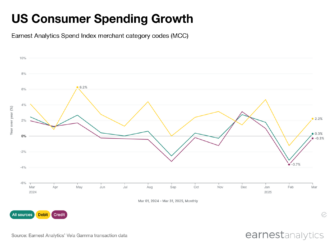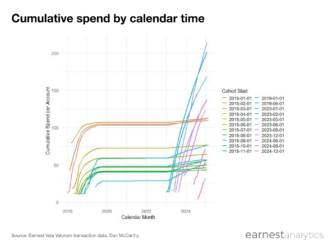Are You Still Watching?
This November, the Over The Top (OTT) Video market will be welcoming its newest members: AppleTV+ and Disney+. The industry has seen multiple new entrants in recent years, with platforms like Sling TV, AT&T TV Now (f.k.a. DirecTV Now) and YouTube TV competing with longstanding incumbents Netflix and Hulu.
We wanted to understand how the OTT Video market has changed over time, from market share shifts to subscriber churn and user overlap among the growing players in the space. To answer these questions and more, we analyzed the OTT Video industry’s spending behavior using data on millions of de-identified U.S. subscribers. Here’s what we found.
Key Takeaways
- Since 2015, the entry of several new OTT video platforms has resulted in market-leader Netflix losing ~20% share of subscribers and ~35% share of dollars in this growing industry.
- The industry’s average monthly bill has almost doubled in size, rising from $12.20 to $23.20, over the last four years. Average monthly churn for the industry has remained low, climbing a modest 150bps since 2016 to 3.3%.
- ~70% of current video-streamers are subscribed to only a single platform, while ~25% are subscribed to two, and ~5% to three or more. Netflix leads the industry in platform exclusivity, with 65% of its current subscribers loyal to its service; all other providers see just ~15% to 30% of a loyal subscriber base.
- ~25% of individuals who pre-registered for Disney+ are not currently subscribed to any of the other 11 OTT video platforms included in this analysis.
Pricing Notes
- AppleTV+ is priced at $5/month, or free for a year with the purchase of a new Apple device
- Disney+ is priced at $7/month ($70/year), or $13 if bundled with ESPN+ and Hulu. In August, D23 fan-club members were given the chance to pre-register for Disney+ at $140/three years; the promotion ended on Labor Day.
State of the Market
The OTT Video market has seen significant market share shifts since 2015. Formerly a two-player* market comprised of Netflix (80%+ share) and Hulu (15%+), new entrants such as Sling TV, DirecTV Now (now rebannered as AT&T TV Now), YouTube TV, and several others have each acquired share over the years.
As a result, since 2015, Netflix’s share of subscribers has fallen ~20% and its share of dollars has fallen ~35%, while Hulu, Sling TV, and YouTube TV have each seen market share grow ~3% to ~10% over the same period. This is likely a function of both a growing base of new subscribers and competition among existing subscribers.


Monthly Bill and Monthly Churn
Over the last four years, the industry’s average monthly bill has almost doubled in size, rising from ~$12.20 to $23.20, highlighted by a few occasional spikes when dominant-player Netflix raised its prices in select quarters.

Looking further at individual providers in the most recent quarter, the majority of platforms see monthly bills of less than $20, with SlingTV, FuboTV, YouTube TV and DirecTV Now at ~$30 to $50. New entrants AppleTV+ and Disney+ appear to be joining the company of ESPN Plus’ $5 and CBS All Access’ $7.

Average monthly churn for the industry has remained low, climbing a modest ~150bps since 2016 to 3.3%; a reflection of Netflix’s low churn and stronghold on the industry.


Overlap and Loyalty
Is there room for subscribers to add yet another platform to their streaming-video entertainment shelf? We looked at current active OTT Video subscribers (as of October 2019) and counted the number of OTT Video platforms that each is subscribed to: 69% of subscribers are subscribed to a single streaming platform, 27% to two, and 4% to three or more platforms, according to our data.

Looking at individual providers, we observed varied behaviors when it comes to multiple platform subscriptions. Netflix appears to lead the industry in platform exclusivity, with 65% of its current subscribers loyal to its service. All other providers see just ~15% to 30% of a loyal subscriber base. Philo, CBS All Access, Showtime, and HBO Now appear to have the least exclusivity, with ~40% to 50% of their users subscribing to three or more platforms.

Disney+ Pre-orders
Since August, we have seen a sample of several thousand individuals pay for Disney+ pre-orders in our data. We expect to see transactions accelerate beginning November 19th, after the 7-day trial expires following the official launch of the service. It’s worth noting that Verizon is giving customers 12 months of Disney+ for free.
Interestingly, ~25% of them are not currently subscribed to any of the other 11 OTT Video platforms included in this analysis, while ~40% are subscribed to one, ~25% to two

Notes and Definitions
- Analysis excludes Amazon Prime Video as we cannot differentiate between Prime members that are actively using the Prime Video platform versus those that are not but are still subscribed to Amazon Prime for faster shipping.
- Data for Netflix includes all subscription types on their platform.
- Many subscriptions that are paid through third-parties such as Amazon, AppleTV, Playstation, and Roku are not identifiable in Earnest data.
- We recognize that our data has under-reported Netflix’s actual subscriber and revenue YoY growth since 2015. Please reach out for a better understanding of our biases and differentials.
- Average Monthly Bill is defined as the sum of panel sales in the quarter divided by the average number of end-of-period subscribers throughout the quarter, divided by three. When calculating average monthly bill for the industry as a whole, individuals who are subscribed to multiple providers are counted as one subscriber in the denominator. This is in order to accurately capture the average amount of total dollars paid to the industry as a whole by unique individuals. Changing the denominator to count multiple subscriptions with its corresponding amount yields an average monthly bill of ~$10.10 to $17.10 over the last four years versus the figures of ~$12.20 to $23.20 in this analysis.
- We consider a subscriber to have churned if Earnest does not see a payment to that particular provider within 65 days of his/her prior bill payment.
- Average Monthly Churn is defined as the sum of churned subscribers in the quarter divided by the average number of end-of-period subscribers throughout the quarter, divided by three. When calculating average monthly churn for the industry as a whole, unlike the average monthly bill logic above, individuals who are subscribed to multiple providers, and have churned from one of them, are counted as one churned subscriber in the numerator, and therefore, his/her multiple subscriptions, in turn, are counted with the corresponding amount in the denominator. This, therefore, captures individual-platform-churn in the industry versus capturing churn from the entire industry. Changing the denominator to consider users’ multiple subscriptions as one unique subscriber yields an average monthly churn of 2.4% to 4.4% over the last four years versus the figures of 1.8% to 3.3% in this analysis.











